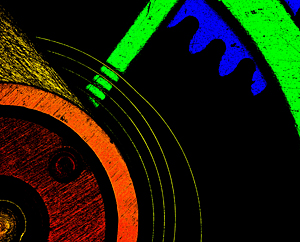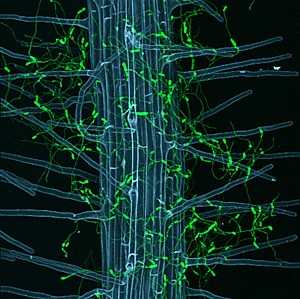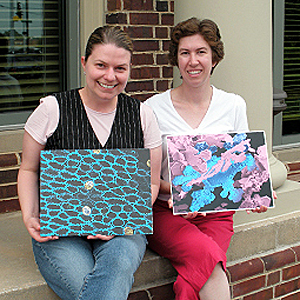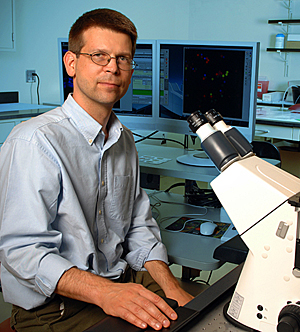



- Rozovsky wins prestigious NSF Early Career Award
- UD students meet alumni, experience 'closing bell' at NYSE
- Newark Police seek assistance in identifying suspects in robbery
- Rivlin says bipartisan budget action, stronger budget rules key to reversing debt
- Stink bugs shouldn't pose problem until late summer
- Gao to honor Placido Domingo in Washington performance
- Adopt-A-Highway project keeps Lewes road clean
- WVUD's Radiothon fundraiser runs April 1-10
- W.D. Snodgrass Symposium to honor Pulitzer winner
- New guide helps cancer patients manage symptoms
- UD in the News, March 25, 2011
- For the Record, March 25, 2011
- Public opinion expert discusses world views of U.S. in Global Agenda series
- Congressional delegation, dean laud Center for Community Research and Service program
- Center for Political Communication sets symposium on politics, entertainment
- Students work to raise funds, awareness of domestic violence
- Equestrian team wins regional championship in Western riding
- Markell, Harker stress importance of agriculture to Delaware's economy
- Carol A. Ammon MBA Case Competition winners announced
- Prof presents blood-clotting studies at Gordon Research Conference
- Sexual Assault Awareness Month events, programs announced
- Stay connected with Sea Grant, CEOE e-newsletter
- A message to UD regarding the tragedy in Japan
- More News >>
- March 31-May 14: REP stages Neil Simon's 'The Good Doctor'
- April 2: Newark plans annual 'wine and dine'
- April 5: Expert perspective on U.S. health care
- April 5: Comedian Ace Guillen to visit Scrounge
- April 6, May 4: School of Nursing sponsors research lecture series
- April 6-May 4: Confucius Institute presents Chinese Film Series on Wednesdays
- April 6: IPCC's Pachauri to discuss sustainable development in DENIN Dialogue Series
- April 7: 'WVUDstock' radiothon concert announced
- April 8: English Language Institute presents 'Arts in Translation'
- April 9: Green and Healthy Living Expo planned at The Bob
- April 9: Center for Political Communication to host Onion editor
- April 10: Alumni Easter Egg-stravaganza planned
- April 11: CDS session to focus on visual assistive technologies
- April 12: T.J. Stiles to speak at UDLA annual dinner
- April 15, 16: Annual UD push lawnmower tune-up scheduled
- April 15, 16: Master Players series presents iMusic 4, China Magpie
- April 15, 16: Delaware Symphony, UD chorus to perform Mahler work
- April 18: Former NFL Coach Bill Cowher featured in UD Speaks
- April 21-24: Sesame Street Live brings Elmo and friends to The Bob
- April 30: Save the date for Ag Day 2011 at UD
- April 30: Symposium to consider 'Frontiers at the Chemistry-Biology Interface'
- April 30-May 1: Relay for Life set at Delaware Field House
- May 4: Delaware Membrane Protein Symposium announced
- May 5: Northwestern University's Leon Keer to deliver Kerr lecture
- May 7: Women's volleyball team to host second annual Spring Fling
- Through May 3: SPPA announces speakers for 10th annual lecture series
- Through May 4: Global Agenda sees U.S. through others' eyes; World Bank president to speak
- Through May 4: 'Research on Race, Ethnicity, Culture' topic of series
- Through May 9: Black American Studies announces lecture series
- Through May 11: 'Challenges in Jewish Culture' lecture series announced
- Through May 11: Area Studies research featured in speaker series
- Through June 5: 'Andy Warhol: Behind the Camera' on view in Old College Gallery
- Through July 15: 'Bodyscapes' on view at Mechanical Hall Gallery
- More What's Happening >>
- UD calendar >>
- Middle States evaluation team on campus April 5
- Phipps named HR Liaison of the Quarter
- Senior wins iPad for participating in assessment study
- April 19: Procurement Services schedules information sessions
- UD Bookstore announces spring break hours
- HealthyU Wellness Program encourages employees to 'Step into Spring'
- April 8-29: Faculty roundtable series considers student engagement
- GRE is changing; learn more at April 15 info session
- April 30: UD Evening with Blue Rocks set for employees
- Morris Library to be open 24/7 during final exams
- More Campus FYI >>
1:07 p.m., Oct. 14, 2009----“Stunning” is not a word most people typically would use to describe a pocket watch or a fungal infection of a plant root.
But the images of these humble subjects photographed by University of Delaware scientists Rebekah Helton and Kirk Czymmek using high-powered microscopes at the Delaware Biotechnology Institute's Bio-Imaging Center may just stop you in your tracks.
The two have won high honors in the 2009 Nikon Small World Competition, which bills itself as “the preeminent forum for the world's best photomicrographers.”
The contest showcases the beauty and complexity of life as seen through a light microscope and recognizes achievements in capturing images at the intersection of science and art.
The 2009 competition, the 35th on record, received more than 2,000 entries from around the globe. Helton's magnified pocket watch titled “Stopwatch” placed 17th among the 20 winners, and Czymmek received an honorable mention for his image of a root of the common laboratory plant Arabidopsis being attacked by a fungus.
This was the first time each had entered the contest.
Helton, who holds a Ph.D. in plant and soil sciences from UD, is a postdoctoral researcher at DBI's Bio-Imaging Center and in the Department of Biological Sciences. She submitted the pocket watch image to show “a unique view of an everyday object.”
As part of a confocal course special project, Helton, as laboratory instructor, quided a student learning to use a Zeiss LSM 510 confocal microscope to take the digital image of the watch. Helton then enhanced the image prior to submission with special “stacking” software that enabled her to shade different levels of depth within the timepiece.
Czymmek, who is an associate professor of biological sciences and director of DBI's BioImaging Center, said he decided to image a fungus infecting the common laboratory plant Arabidopsis because it was novel.
“Maintaining the delicate plant roots while watching the disease process in living samples without damaging them was part of the challenge, as well as coming up with an aesthetically pleasing image,” he says.
He used a confocal microscope to create a three-dimensional image of the highly magnified plant root. He received an Honorable Mention, one of 15 awarded in a new category established this year by Nikon to recognize “outstanding photomicrographs that demonstrate superior technical competency and artistic skill.”
Czymmek says he's pleased with the recognition his team of scientists at the DBI Bio-Imaging Center have achieved this year and will be framing UD's Nikon-honored images for display at the center alongside other winning images.
At the 2009 Microscopy & Microanalysis Meeting this past July, Deborah Powell, a research associate at the DBI Bio-Imaging Center, won first place with her image of snow crystals, and Helton won second place for her view of flower pigment cells and pollen grains.
“Scientific data is not about pretty pictures even though the University of Delaware has outstanding imaging resources and competence available to its researchers,” Czymmek says. “However, almost daily, we can observe the inherent aesthetic beauty in living cells and other tiny structures with our microscopes and it is great to have the opportunity to share them beyond our hallways.”
Helton and Czymmek both plan to enter the Nikon Small World Competition next year.
“I feel honored to have placed among the top 20, and I hope I can do the same next year,” Helton says.
What will be the subject for her next image?
“My mind is already trying to come up with ideas, but I have not settled on a final decision,” she says. “You will have to wait and see.”
The 2009 winning images may be viewed on this Web site. The top images also will be exhibited in a full-color 2010 calendar and through a national museum tour, according to Nikon.
Article by Tracey Bryant


